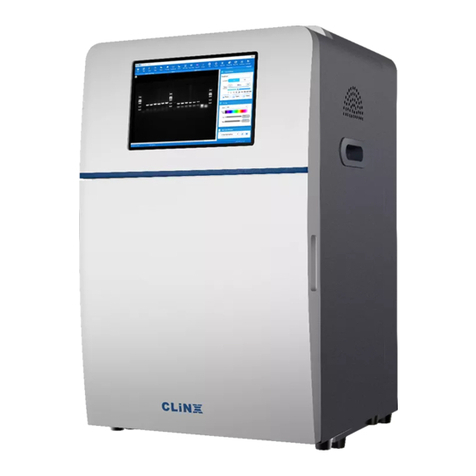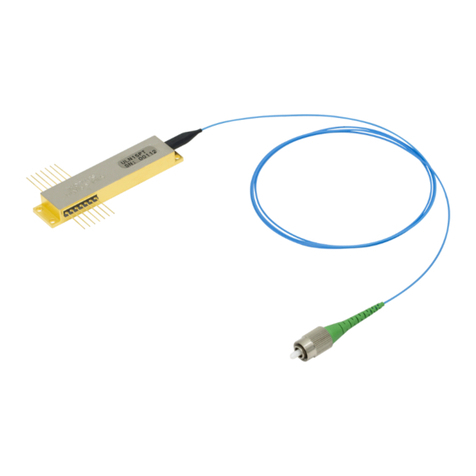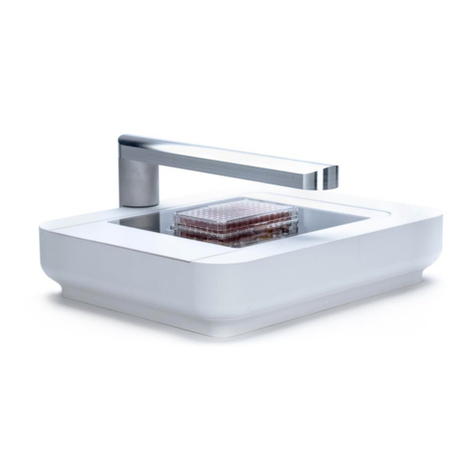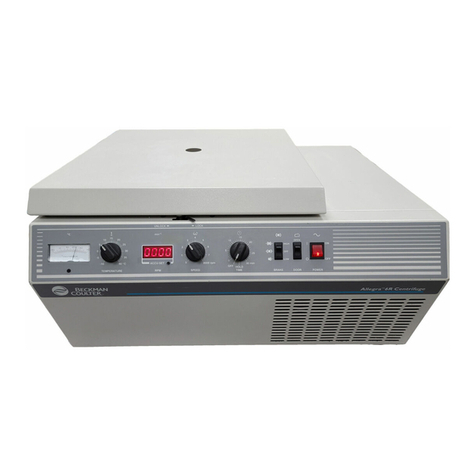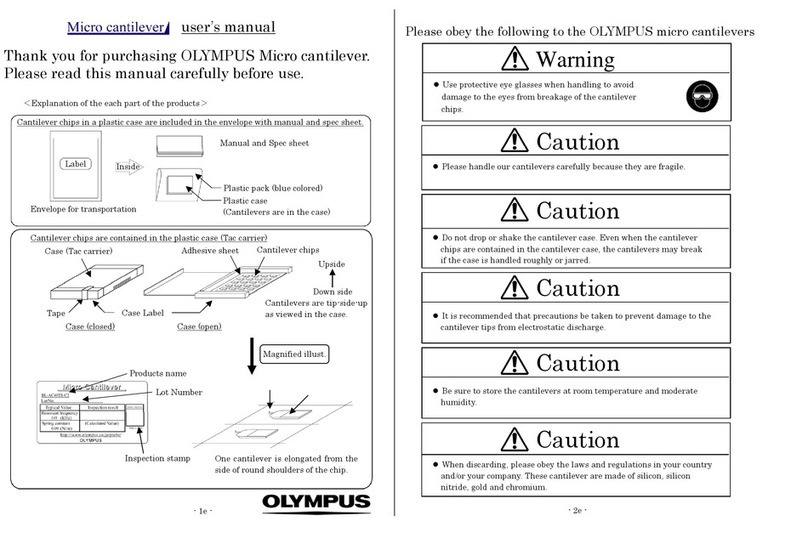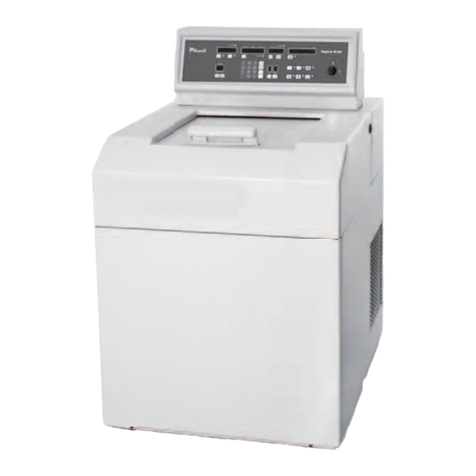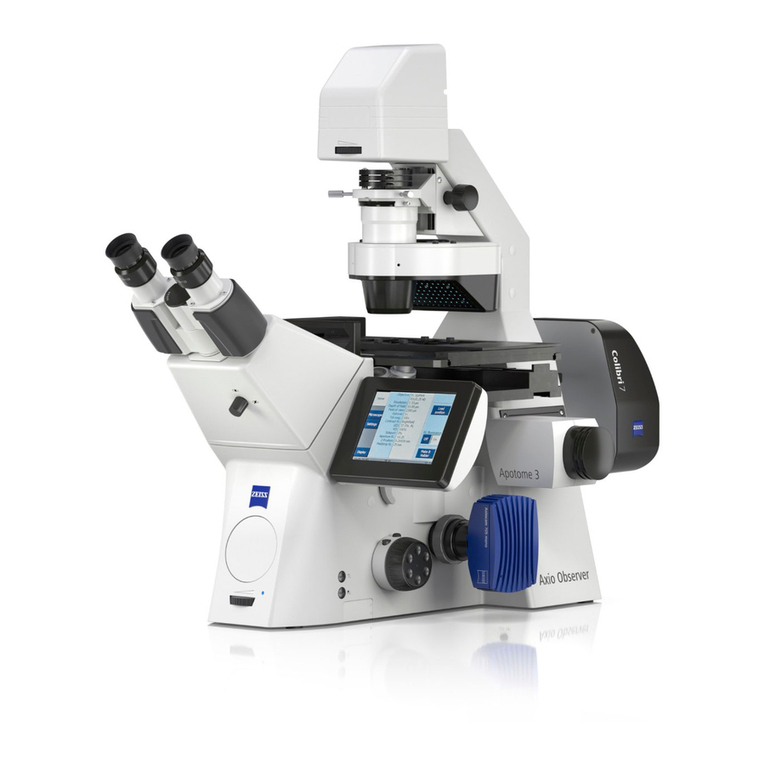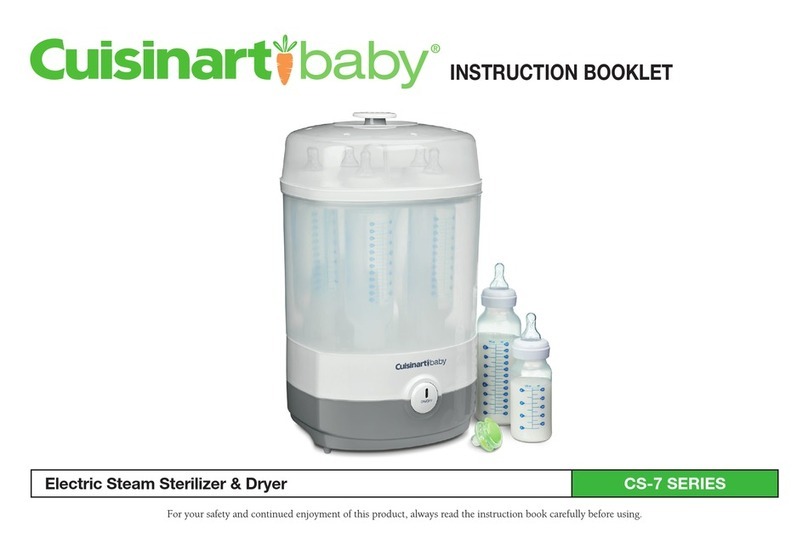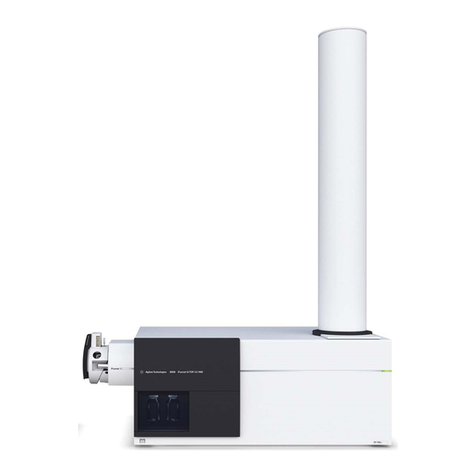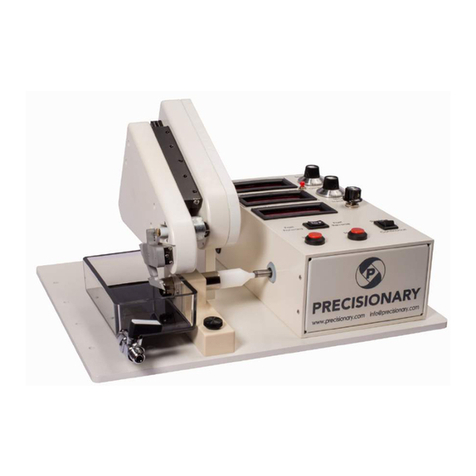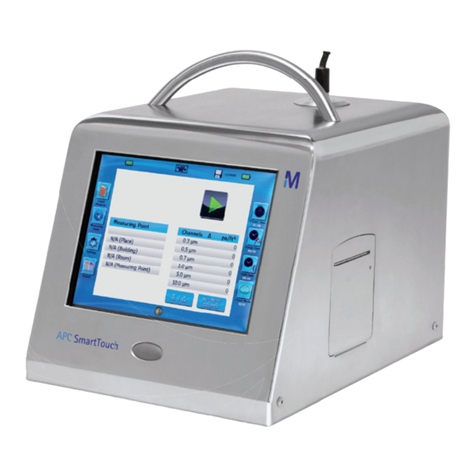Clinx XinPRO User manual

XinPRO
Mini Vertical Electrophoresis Cell
User Manual

Content
01 Brief introduction------------------------------------------------------------ 1
02 Component--------------------------------------------------------------------1
03 Technical specification------------------------------------------------------4
04 Safety Information----------------------------------------------------------- 5
05 Installation and basic operation-------------------------------------------- 6
06 Trouble shooting------------------------------------------------------------- 16
07 Quality guarantee------------------------------------------------------------ 20
08 Technical Support------------------------------------------------------------20

1 2
01 Brief introduction
XinPRO Vertical Electrophoresis Cell is used to run pre-casting gel and
hand-casting gel, at most 4 pieces of gels are available simultaneously. It is
compatible with 1-D and 2-D electrophoresis application. The gel-making
frame and glass plate with fastening side strip make the activity of hand-casting
gel simple and avoid the leakage.
02 Component
In order to achieve best performance, please read the instruction manual
carefully and operate the instrument strictly according to the instruction
manual.
①Glass plate with fastening side stripe: It is the relatively high glass plate with
fastening side stripe. There are 3 kinds of glass plate with the thickness of
0.75mm, 1.0mm, 1.5mm respectively.
②Short glass plate: It is the relatively short glass plate and combined with
glass plate to form the gel sandwich clamp.
③Gel-casting frame: It is put on the desk and align the short glass plate and
glass plate with fastening side strip, and make sure to form the gel sandwich
clamp.
④Components of gel clamp: 1 piece of gel casting frame, a piece of glass
plate with fastening side stripe and a piece of short glass plate.
⑤Gel base: Pressure leverage seal the components of gel to the gel casing pad
to avoid the leakage of gel.
⑥Gel sandwich: It consists of short glass plate and glass plate with side strip
as well as polymer gel.
⑦Replacement plate for single gel: Transparent mound pressing baffle, it is
used to make 1 piece of gel or 3 pieces of gels.
⑧Electrophoresis core: It is used to hold the gel sandwich and supply the
U-sealing strip and upper and lower electrode as well as connecting plug.
Anode is marked by red while the cathode is marked by black.
⑨Buffer tank and upper lid: The buffer tank and the upper lid are closed to
make sure the electrophoresis is conducted smoothly. The power is off when
the upper lid is opened. The tank and upper lid are compatible with other
electrophoresis module, such as the electrophoresis transfer, 2-D single
direction electrophoresis and electrophoresis elution etc.
⑩Comb: The comb with side teeth and inner-built ridge are isolated from air
to avoid the polymerization reaction of inhibition glue.
⑪Glass plate support
⑫multi-functional gel scraper
⑬the gray gel gasket
⑩⑪ ⑫ ⑬
Figure 1:Accessories
①
⑤
③
②

3 4
Figure 2: XinPRO electrophoresis installation
03 Technical specification
Model
XinPRO-4
XinPRO-2
Gel quantity
1-4 pieces
1-2 pieces
Gel thickness
1.0mm(standard) 、0.75mm、1.5mm
Glass plate
100×83mm
Gel area
83×73mm
Comb
specifications
1.0mm 10 wells,15 wells,(standard),
0.75mm 10 wells,15 wells.
1.5mm 10 wells ,15 wells.
Precast gel
Compatible with BIO-RAD,PIERCE,INVITROGEN
Dimension
180×130×160mm
Maximum volume of sample
Hole quantity
Width of hole
0.75 mm
1.0 mm
1.5 mm
5
12.7 mm
70 μl
105 μl
160 μl
9
5.08 mm
33 μl
44 μl
66 μl
10
5.08 mm
33 μl
44 μl
66 μl
15
3.35 mm
20 μl
26 μl
40 μl
IPG
6.2 mm
----
420 μl
730 μl
Prep/2-D
Reference well
3.1 mm
13 μl
17 μl
30 μl
Sample well
71.7 mm
310 μl
400 μl
680 μl
⑥Gel sandwich
⑨upper lid
⑨Buffer tank
⑧Electrophoresis core
U-sealing strip
Electrode plug
⑦Replacement plate

5 6
04 Safety Information
The power is off when the upper lid is opened, never try to operate the
electrophoresis when there is no upper lid.
Note: The safety standard is applied to the Clinx product from design stage to
production stage, and it would be safe in case of proper and right operation.
Please do not improve or mend it by any means.
Compatibility of chemical reagent:
All the components of XinPRO electrophoresis cell should be kept clear of
acetone and ethyl alcohol. The damage caused by using the organic reagent is
not covered by the guarantee policy.
The comb of XinPRO electrophoresis cell should be kept clear of 100%
TEMED, whose structure will be damaged by long time friction of TEMED.
05 Installation and basic operation
1.Preparing gel plate
Hand casting gel
Note to installation of glass plate clamp and gel casting frame
a. Put the gel casting frame vertically on the horizontal desk and let the door of
gel casting frame open.
b. Choose the glass plate with side strip according to the thickness of gel and
put the shore glass plate above (Please refer to the figure 3a).
c. Keep the marked tip of glass plate with side strip up, slide 2 pieces of glass
plates into the gel casting frame, make the face of shore glass forward (Please
refer to the figure 3b).
Note: Keep the 2 pieces of glass plates on the same level and right direction of
marker. The leakage occurs in case of wrong direction of glass plate and
non-aligning.
d. Close the hinge of gel casting frame if the glass plate is in the right position,
clamp the glass plate tightly in gel casting frame (Please refer to figure 3c).
Check the bottom of glass plate is level.
e. Keep the hinge of gel casting frame outward and put the gel casting frame
on the gray gel gasket of gel base, the put the spring leverage on the glass plate
with side strip (Please refer to figure 3d).
f. Repeat step a-e to make another gel plate.

7 8
Figure 3: Installation of gel casting frame and gel base.
Gel casting
a. Non continued polyacrylamide gel
1) Put the comb into the gel clamp completely and mark the part 1 cm blow
the lower end of tooth. The mark indicates the height of separated gel.
2) Blend all the reagent except APS and TEMED to make gel single solution
(Please refer to gel list of chapter 4), vacuum degassing for more than 15
minutes.
3) Put APS and TEMED in single solution after being vacuum degassed, and
use the pipette or sample adding pipette to inject the solution between
glass plate until reach the marker. Keep stable injection in order to avoid
the blend with air.
4) Cover the surface of solution by water or tert-amyl alcohol (2- methyl, 2-
butanol). Note: Please inject the water slowly and stably in order to avoid
blend with air.
5) Leave the gel from 45 minutes to 60 minutes until it is of polymerization.
Cleanse the surface of gel completely by double distilled water. Do not let
the matters of alcohol kind stay on the gel more than 1 hour in order to
avoid the dehydration of upper part of gel.
Note: Such separated gel can be store in room temperature overnight. Add 5 ml
of 1.5MTri-HCl with ratio of 1 to 4 and buffer with pH8.8 (Laemmli system) to
the separated gel to be dried. In case of other buffer, please add 5 ml of 1 fold
diluted solution.
6) Prepare spacer gel single solution, blend all the reagents except APS and
TEMED, vacuum degassing for more than 15 minutes.
7) Use the filter paper to dry the surface of separated gel before injecting
spacer gel.
8) Add APS and TEMED in the degassed spacer gel single solution and
inject the solution until it reaches the level the glass plate.
9) Insert comb and make sure that the back of comb and the glass plate are
on the same level.
10) Leave the gel from 45 minutes to 60 minutes until it is of polymerization.

9 10
11) Take out the comb slightly and cleanse the surface of gel by distilled water
and buffer.
12) Cleanse the used gel clamp frame and gel casting frame by distilled water
and ion-removing water.
b. Continued polyacrylamide gel
1). Blend all the reagent except APS and TEMED to make gel single solution
(Please refer to gel list of chapter 4), vacuum degassing for more than 15
minutes.
2). Put APS and TEMED in single solution after being vacuum degassed, and
inject the solution until it reaches the level the glass plate.
3). Insert comb and make sure that the back of comb and the glass plate are on
the same level.
4). Leave the gel from 45 minutes to 60 minutes until it is of polymerization.
5). Take out the comb slightly and cleanse the surface of gel by distilled water
and buffer.
And cleanse the used gel clamp frame and gel casting frame by distilled water
and ion-removing water.
2 Installation of electrophoresis module and adding sample
Clean and dry XinPRO electrophoresis buffer tank.
Electrophoresis module (Electrophoresis core can only be used for 1 piece gel
or 2 pieces of gels, the shared module should be used in case of 3 pieces of gels
or 4 pieces of gels.
1) Installation
Note: If only run 2 pieces of gels, please use electrode head electrophoresis
core. If only run 4 pieces of gels, please use the electrode head electrophoresis
core and mushroom head electrophoresis core, each module for 2 pieces of
gels.
a. Put the opened gel-casting frame on the clean and horizontal surface of desk
(Please refer to the figure 4a).
b. Adjust the short glass plate inwardly, put the first gel sandwich on the gel
supporter, put the module of gel supporter on both two sides of bottom of
module, each side with two, in case of which, there is a 30 degrees angle
between the middle side of gel plate. Be careful to put the first gel and keep
balance, then put the second gel on the other side of gel supporter. There are
totally 2 pieces of gel slant from the center (Please refer to the figure 4b).

11 12
c. Note: Be sure to adjust the short glass plate inwardly and then put the gel on
the two sides of gel clamping frame. The gel clamping frame requires 2 pieces
of gels to form the functional module. In case of running odd number of gel (1
piece of gel or 3 pieces of gels), please use single gel plate (Please refer to
figure 4b).
d. Push 2 pieces of gel plates slightly to the center and close to gel band, to
make sure that the short glass plate is under the concaved tank of gel gasket.
e. Compress the gel plate tightly by one hand, while close the gel clamp frame
by another hand and make it in the best position. Or hold the whole unit and
stabilize the gel plate and close gel clamp frame on both two sides in order to
make it be locked in the right position (Please refer to the figure 4c). The gel
clamp frame pushes the gel plate and make the concaved tank of short glass
plate and concaved tank of gel gasket matched together tightly in order to avoid
the leakage of liquid (Be sure the the short glass plate is under the bottom of
concaved tank of gel gasket). Thus, use the buffer to cleanse the sample and
start to add the sample (Please refer to the figure 4b).
Important note: Never try to close the gel clamp frame when the gel plate
is not under the bottom of concaved tank of gel gasket. In order to avoid the
movement of gel plate in the process of being locked, please use single hand
to compress the gel plate on the two sides of gel clamp frame stably and
evenly.
Note: Please do not put mushroom head electrophoresis core in the
electrophoresis cell, otherwise the surplus heat is generated which affects the
result of electrophoresis separation.
Figure 4: Installation of XinPRO electrophoresis module.
2) Sample adding
a. Inject the buffer into the tank, from the outside of outer tank and follow
lower part of glass plate, just flood the short glass plate slightly.
b. Add the sample before or after the electrophoresis core is put in the
electrophoresis cell, both of two methods are available to obtain the satisfied

13 14
result.
c. Add the sample into the hole by syringe and sample adding pipette.
Note: Make the sample fall onto the bottom of hole slowly and evenly. Be sure
not to puncture the bottom.
Note: Anode and cathode should be flooded by the buffer and on the same
level.
3) Put the electrophoresis module in the buffer tank.
Note: The volume requires, 2 pieces of gels with 700ml, 4 pieces of gels with
1000ml.
There are two places of buffer tank for two module: Electrophoresis core is
second and the mushroom head electrophoresis core is first.
a. Put the XinPRO buffer on the smooth desk, make the front side (The side
indicating the words of 2 gels and 4 gels) forward. If the direction is correct,
the red mark of edge of tank should be on the right side and the black left.
b. If running 2 pieces of gels, please use the electrophoresis core with plug. Put
it on the back and make the red (+) corresponding to the red mark on the right
side of tank.
c. If running 4 pieces of gels, please us not only the electrophoresis core with
plug but also the mushroom head electrophoresis core that should put in the
front. Make the red (+) of the two corresponding to the red mark on the right
side of tank. Note: The wrong direction and position will make the upper lid
impossible to be closed.
d. Put the buffer into the tank until reach the marker.
4) XinPRO installation of buffer tank
Put the upper lid on the buffer tank, and make sure the plug and socket match
to obtain the right location, the protruded part of upper lid can help avoid the
error. Note: The two protruded parts of buffer tank should go through the slot
of upper lid in order to make it open and close smoothly. At this time, please
compress the upper lid continuously with thumb until is is done.
5) Power condition
a. Insert the plug into the socket correctly.
b. Power on the XinPRO, the constant voltage is 200V is recommended to
SDS-PAGE and most of native PAGE. 200V voltage can be used to run 2
pieces of gels and 4 pieces of gels. The customer choose the voltage according
to the real situation. SDS-PAGE needs around 35 minutes under the voltage of
200V.
6) Extract gel
a. Power off and take out the plug when the electrophoresis is done.
b. Open the upper lid, take out the electrophoresis core carefully, and remove
the buffer. Please pour out the buffer before open the clamp.

15 16
c. Take out the gel plate.
d. Separate the two glass plates carefully and take out the gel.
e. Put the gel downward and immerse the gel and glass plate in the buffer and
make them separated.
f. Cleanse the XinPRO electrophoresis core and buffer tank by the
ion-removing distilled water.
06 Trouble shooting
Problem
Cause
Solution
Smile effect –
band pattern
curves upward
at both sides
of the gel
Center of the gel
running hotter
than either end
Power conditions
excessive
Buffer not mixed well or
buffer in upper chamber too
concentrated. Remake
buffer, ensuring thorough
mixing, especially when
diluting 5x or 10x stock.
Decrease the power setting
from 200 V to 150 V or fill
lower chamber to within 1
cm of top of short plate.
Vertical
streaking of
protein
Sample
overloaded
Sample
precipitation
Dilute sample, selectively
remove predominant protein
in sample, or reduce the
voltage about 25% to
minimize streaking.
Centrifuge sample before
addition of SDS sample
buffer, or decrease %T of the
gel*
The ratio of SDS to protein
should be enough to coat
each protein molecule with
SDS, generally 1.4:1.
It may require more SDS for
some membrane protein
samples.
Lateral band
spreading
Diffusion of the
wells prior to
turning on the
current.
Ionic strength of
the sample lower
than that of the
gel.
Minimize the time between
sample application and
turning on the power
start-up.
Use same buffer in sample
as in the gel or the stacking
gel.

17 18
Problem
Cause
Solution
Skewed or
distorted band
Poor
polymerization
around wells
Salts in sample
Uneven gel
interface
Degas stacking gel
solution completely prior
to casting; +C2:C5
increase ammonium
persulfate and TEMED
concentrations by 25%,
for stacking gel or
low %T, leave APS the
same and double the
TEMED concentration.
Remove the salts by
dialysis, desalting,
column, etc.
Decrease the
polymerization rate.
Overlay gels very
carefully.
Lanes
constricted at the
bottom of the gel
Ionic strength of
sample higher than
the surrounding
gel
Desalt sample and
neighboring samples.
Run taking
unusually long
Running buffer too
concentrated
Excessive salt in
sample
Check buffer protocol,
dilute if necessary
Desalt sample
Run too fast
Running or
reservoir buffer too
dilute
Voltage too high
Check buffer protocol,
dilute if necessary
Decrease voltage by
25–58%
Problem
Cause
Solution
Doublets
observed where
single protein
species is
expected
(SDS-PAGE)
A portion of the
protein may have
been re-oxidized
during the run or
may not have been
fully reduced prior
to the run
Prepare fresh sample
buffer solution if over 30
days old
Increase concentration in
the
sample buffer
Substitute DTT for
BME
Fewer bands
than expected
and one heavy
band at the dry
front
Protein(s)
migrating at the
dye front
Protein
degradation
Increase the %T of the
resolving gel
Use protease inhibitors,
e.g., PMSF, etc
Fewer bands
than expected
and one heavy
band at the dry
front
Protein(s)
migrating at the
dye front
Protein
degradation
Increase the %T of the
resolving gel*
Use protease inhibitors,
e.g., PMSF, etc.
Upper buffer
chamber leaks
Upper buffer
chamber overfilled
Improper assembly
Keep buffer level below
the top of the spacer plate
Be sure U-shaped
electrode core gasket is
clean, free of cuts, and
lubricated with buffer
Be sure short plate is
under the notch on the
gasket, not on top of it

19 20
Problem
Cause
Solution
Leaking during
hand casting
Chipped glass
plates
Spacer plate and
short plate not
level
Casting stand
gasket is dirty,
flawed, or
worn out.
Ensure glass plates are
free of flaws
Ensure plates are aligned
correctly
Wash the gasket if it is
dirty, replace casting
stand gaskets if flawed or
worn out
Poor end well
formation
Incorrect catalyst
formation
Monomer solution
not degassed
Oxygen inhibits
polymerization
Prepare fresh catalyst
solution, or increase the
catalyst concentration of
the stacking
gel to 0.06% APS and
0.12% TEMED
Degas monomer solution
immediately prior to
casting the
stacking gel
Webbing/excess
acrylamide
behind the comb
Incorrect catalyst
concentration
Prepare fresh catalyst
solution,
or increase the catalyst
concentration of the
stacking gel to 0.06%
APS and 0.12%
TEMED
The pressure
cams on the
casting frame
are difficult to
close or make
noise when
closed
Powder residue
has built up at the
pivot
of the pressure
cams
Rinse or wipe off the
powder residue before
each use
07 Quality Guarantee
1. The warranty is 1 years since the date of sales.
2. The warranty excludes the following situations otherwise it is charged/
a. No presentation of warranty card and invoice.
b. The invoice is revised.
c. Improper operation or accident factors.
d. The damage is caused by the user’s repair.
e. Out of the warranty, the instrument is still in usage after repair.
08 Technical Support
If you have any questions about the use or operation of the products, please
contact us.
Clinx Science Instruments Co., Ltd.
Address: 5C-102, 258 West SongXing Road, Baoshan District, Shanghai,
200940, China
Email: info@clinxsci.com
Website: www.clinxsci.com
This manual suits for next models
2
Table of contents
Other Clinx Laboratory Equipment manuals
Popular Laboratory Equipment manuals by other brands
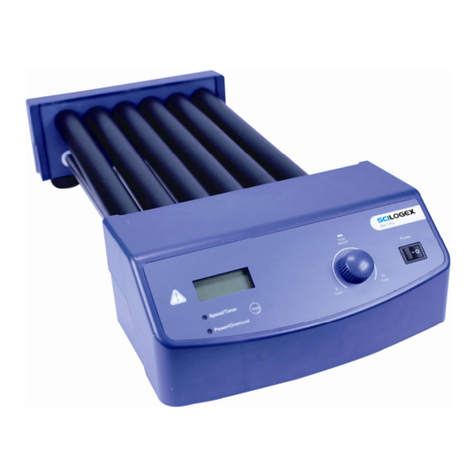
Scilogex
Scilogex MX-T6-Pro user manual

Ocean Optics
Ocean Optics SpectroClip-R Installation and operation manual
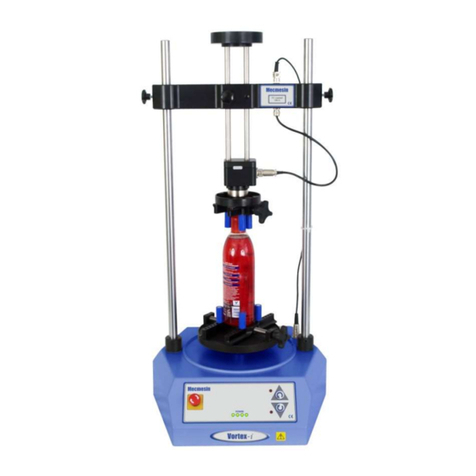
Mecmesin
Mecmesin MultiTest-i Series Assembly and installation
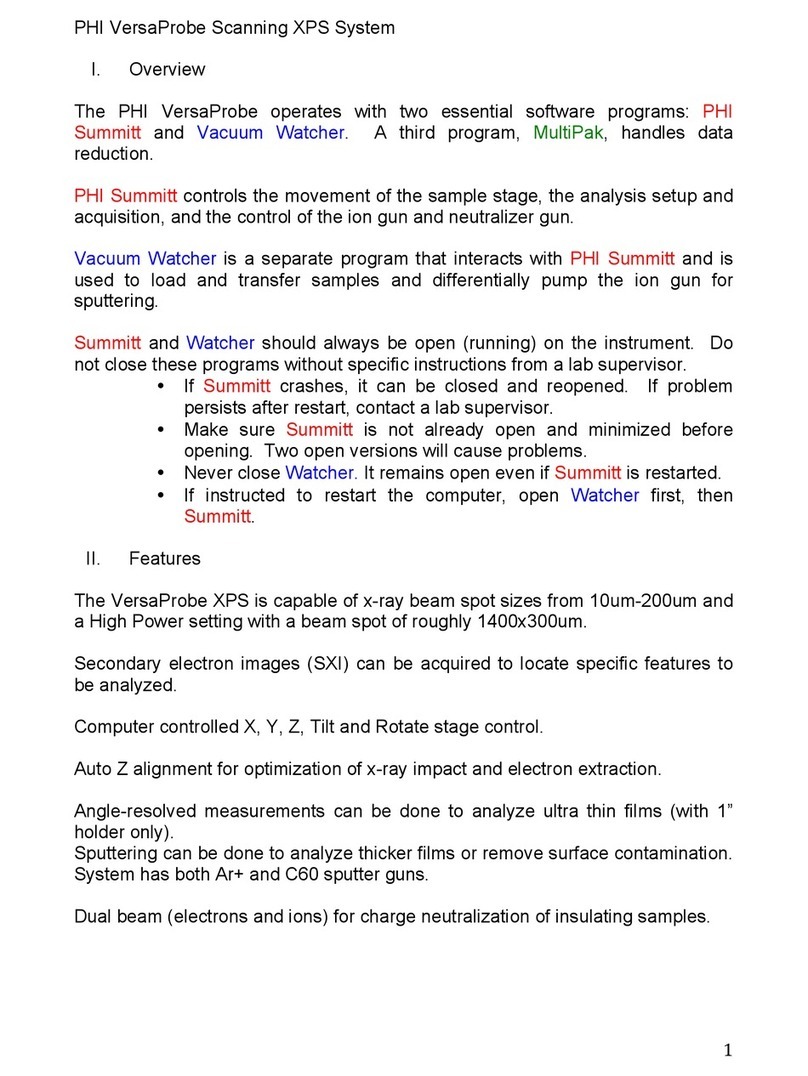
PHI
PHI VersaProbe Operations

NuAire
NuAire LabGard NU-581-400 Operation and maintenance manual

Metrohm
Metrohm 883 Basic IC plus manual
